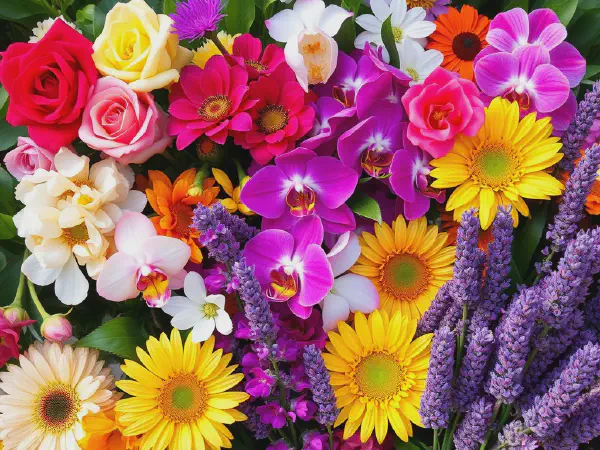Discover the Diverse Types of Flowers and Their Beauty

A Comprehensive Guide to Types of Flowers
Flowers come in various forms, colors, and sizes, each type offering unique beauty and significance. Understanding the types of flowers can enhance our appreciation for nature and assist us in making informed choices, whether for gardening, gifting, or decoration. This article will explore different types of flowers, their categories, meanings, and how they can be used effectively in various settings.
Types of flowers can be divided into several categories based on their lifecycle, growth habits, and characteristics. For instance, some flowers bloom every year, known as annuals, while others return seasonally, known as perennials. Each type has specific care requirements and ideal conditions for growth, making it essential to understand these differences for successful gardening. This guide will provide detailed insights into popular flowers, their meanings, and how to cultivate them within your space.
Popular types of flowers like roses, tulips, daisies, and orchids are cherished not only for their beauty but also for their cultural significance. For example, roses symbolize love and passion, while tulips convey a sense of cheerfulness and springtime. Daisies represent innocence and purity, and orchids, with their exotic allure, are often regarded as a symbol of luxury. Understanding the nuances of these flowers can help you choose the right types for specific occasions and create meaningful experiences.
Additionally, flower colors play a crucial role in conveying emotions and messages. Each color carries its own symbolism, influencing how flowers are perceived and used in various situations. From red flowers that express passionate love to yellow flowers representing friendship and joy, to white flowers signifying purity and remembrance, the colors enhance the message behind the flowers, making them an integral part of social and personal interactions.
Whether you're an experienced gardener or someone just starting, knowing how to grow different types of flowers is essential. Techniques such as seeding, transplanting, and growing in containers can all yield beautiful blooms. Moreover, flowers have diverse applications, from enhancing landscapes, contributing to culinary dishes, offering medicinal benefits, to being featured in crafts and decorations. This article will delve into these aspects, ensuring you gain a comprehensive understanding of types of flowers.
Popular Types of Flowers
Roses are one of the most popular and recognizable types of flowers around the world. They come in various varieties, each with its own meaning and beauty. For instance, red roses symbolize love and passion, while yellow roses convey friendship and joy. Beyond their colors, roses can also have different types—Tea roses, Hybrid tea roses, Floribunda roses, and more—each offering unique traits in fragrance, form, and bloom time.
Tulips are a spring favorite, known for their vibrant colors and simple elegance. They bloom in a myriad of hues, from bright reds and yellows to soft pastels. Tulips thrive in well-drained soil and prefer sunny locations. The different varieties also bloom at different times, making it possible to enjoy tulips from early spring to late spring, extending the beauty of these flowers in your garden.
Daisies are a charming and cheerful type of flower that symbolizes innocence and purity. Originating from Europe, these flowers are now found worldwide. They require minimal care, thriving in sunny environments and well-drained soil. Additionally, their simple beauty makes them a popular choice for bouquets and arrangements, often used in celebrating happy occasions like birthdays and weddings.
Orchids are one of the most exotic types of flowers, known for their intricate and unique shapes. With thousands of species and variations, orchids can be found in almost every color imaginable. Growing orchids require specific conditions, including humidity and temperature control. However, with the right care, they can reward you with stunning blooms that can last for weeks, making them a luxurious addition to any floral collection.
Flower Categories
Flowers can generally be categorized into four primary types based on their lifecycle: annuals, perennials, biennials, and wildflowers. Annual flowers complete their life cycle in one growing season, blooming, seeding, and dying within a year. Examples include marigolds, petunias, and zinnias. Ideal for seasonal planting, they provide vibrant colors for summer gardens.
Perennials, in contrast, live for multiple years, flowering seasonally and returning year after year. Care for perennials often includes proper watering, mulching, and deadheading to encourage new blooms. Some popular perennial flowers include peonies, daylilies, and coneflowers. They are especially useful for creating long-lasting gardens with minimal annual replanting.
Biennials complete their life cycle in two years, typically focusing on leafy growth in the first year and blooming in the second. Examples include hollyhocks and foxgloves. This growth cycle makes them less commonly used but still valuable for creating variety and depth in flower beds over time.
Wildflowers are native plants that grow in the wild without cultivation. They are an essential part of the ecosystem, attracting pollinators and contributing to biodiversity. Identifying wildflower species can vary greatly depending on the region, and they often require minimal care once established, making them an excellent option for natural gardens.
Flower Colors and Their Meanings
Red flowers symbolize passion and love, making them a popular choice for romantic occasions. Roses, poppies, and gerbera daisies are examples of red flowers that convey deep emotions. Their vibrant hue is often associated with strong feelings, making them ideal for gifts on anniversaries, Valentine's Day, or special romantic gestures.
Yellow flowers evoke feelings of friendship and joy. With their sunny disposition, flowers like sunflowers, daffodils, and yellow roses brighten any space and are perfect for celebrations and cheerful events. They can help express warmth and happiness in social gatherings and gift-giving situations.
White flowers symbolize purity and remembrance, which is why they are often used in weddings and memorial services. Lilies, daisies, and orchids in white hues convey elegance and peace, making them suitable for creating serene arrangements or thoughtful gestures during sensitive times.
Blue flowers are associated with calmness and serenity. Flowers like bluebells, hydrangeas, and delphiniums can create a soothing atmosphere in gardens and homes. The tranquil shades of blue are often utilized in spaces designed for relaxation and reflection, promoting a calming effect.
Growing Types of Flowers
Starting flowers from seeds is an exciting process that requires patience and care. Best practices include selecting high-quality seeds, using well-draining soil, and providing adequate sunlight and moisture. Tools such as seed trays, labels, and sprays can help in managing the initial growth stages, ensuring healthy and strong seedlings.
Transplanting flowers involves moving plants from one location to another, which can be necessary as they grow. Timing is crucial—typically done in spring or fall—when the plants are dormant or actively growing. Proper methods include preparing the new site, transplanting at the right depth, and watering adequately to ensure a smooth transition.
Container gardening is ideal for those with limited space or for cultivating certain flower types. Ideal flowers for containers include petunias, geraniums, and begonias, as they thrive in limited space. It's essential to provide proper drainage and regular watering to ensure the flowers remain healthy and vibrant.
Flower beds can enhance the landscape and provide a focal point in any garden. Designing a flower bed involves planning for color schemes, bloom times, and complementary flower types. Regular maintenance, including weeding, mulching, and pruning, is necessary to keep flower beds looking their best while promoting healthy growth.
Uses of Flowers
In landscaping, flowers enhance home aesthetics by adding color, texture, and fragrance to outdoor spaces. Flower arrangements can create visual interest, attract pollinators, and improve property value. Selecting the right types of flowers for specific locations can maximize their impact and create a welcoming environment.
Some flowers are also edible and used in cooking, such as nasturtiums, pansies, and lavender, adding unique flavors and presentations to dishes. Recipes featuring edible flowers can range from salads to desserts, showcasing their culinary versatility and enhancing the dining experience.
In medicine, many flowers possess herbal properties that can be beneficial for health. Flowers like chamomile and calendula are often used in herbal remedies, skincare products, and teas. Understanding the medicinal uses of different flowers can provide alternative healing options and promote wellness.
Finally, flowers are widely used in crafts, such as creating stunning arrangements and decorations for various occasions. Florists and DIY enthusiasts often use flowers to express emotions or themes for events, making them an essential part of celebrations and personal projects.
